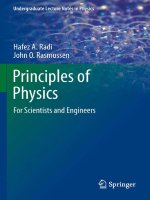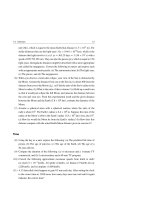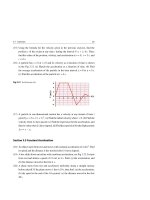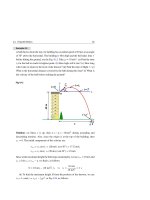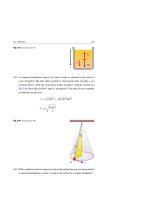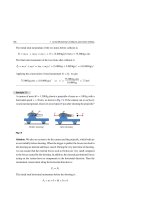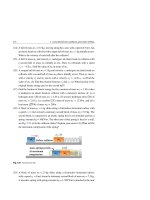Hafez a radi, john o rasmussen auth principles of physics for scientists and engineers 10
Bạn đang xem bản rút gọn của tài liệu. Xem và tải ngay bản đầy đủ của tài liệu tại đây (554.41 KB, 20 trang )
216
7 Linear Momentum, Collisions, and Center of Mass
(24) A ball of mass m1 = 0.5 kg, moving along the x-axis with a speed of 5 m/s, has
an elastic head-on collision with a target ball of mass m2 = 1 kg initially at rest.
What is the velocity of each ball after the collision?
(25) A ball of mass m1 and velocity v1 undergoes an elastic head-on collision with
a second ball of mass m2 initially at rest. Then m1 rebounds with a speed
v1 = −0.5v1 . Find the value of m2 in terms of m1 .
(26) A croquet ball of mass m1 = 1 kg and velocity v1 undergoes an elastic head-on
collision with a second ball of mass m2 that is initially at rest. Then m1 moves
with a velocity v1 and m2 moves with a velocity v2 = (4/5)v1 . (a) Find the
value of m2 . (b) Find the relation between v1 and v1 . (c) What fraction of the
original kinetic energy goes to the second ball?
(27) Find the fraction of kinetic energy lost by a neutron of mass m1 = 1.01u when
it undergoes an elastic head-on collision with a stationary nucleus of: (a) a
hydrogen atom (11 H) of mass m2 = 1.01 u, (b) a heavy hydrogen atom (21 H) of
mass m2 = 2.01 u, (c) a carbon (12
6 C) atom of mass m2 = 12.00 u, and (d) a
lead atom (208
82 Pb) of mass m2 = 208 u.
(28) A block of mass m1 = 1 kg slides along a frictionless horizontal surface with
a speed v1 = 4 m/s toward a stationary second block of mass m2 = 0.5 kg. The
second block is connected to an elastic spring that is not stretched and has a
spring constant kH = 100 N/m. The other end of that spring is fixed to a wall,
see Fig. 7.35. (a) Is the collision elastic? Explain your answer. (b) What will be
the maximum compression of the spring?
Fig. 7.35 See Exercise (28)
(29) A block of mass m1 = 2.5 kg slides along a frictionless horizontal surface
with a speed v1 = 8 m/s toward a stationary second block of mass m2 = 7.5 kg.
A massless spring with spring constant kH = 1,920 N/m is attached to the near
7.7 Exercises
217
side of m2 , as shown in Fig. 7.36. (a) Is the collision elastic? Explain. (b) What
is the speed of the mass-spring system at the maximum compression? (c) What
will be the maximum compression of the spring? (d) What will be the final
velocities of the two blocks?
2=0
1
m1
m2
Before collision
mass-spring system
At maximum
compression
m2
m1
′
′
2
1
m2
m1
After collision
Fig. 7.36 See Exercise (29)
(30) Repeat Exercise (29), this time with m1 = 7.5 kg and m2 = 2.5 kg.
(31) Show that the fraction of kinetic energy transferred to the target in Example
7.5 is independent of the value of the speed of the projectile, v1 . Then, redo
this example when m2 = 3m1 .
(32) A hockey puck traveling at 30 m/s on a smooth ice surface is deflected by
θ1 = 30◦ from its original direction when it collides elastically with a second
stationary identical puck. The second puck acquires a velocity at θ2 = 60◦ from
the original velocity of the first puck, see Fig. 7.37. Find the speed of the pucks
after the collision.
Before
collision
1
y
2= 0
x
At rest
Hockey
pucks
Fig. 7.37 See Exercise (32)
′
y
1
θ1
After
collision
x
θ2
′
2
218
7 Linear Momentum, Collisions, and Center of Mass
(33) If each angle in Exercise (32) is equal to 45◦ , then show that only the application
of conservation of momentum is enough to find the speed of the pucks after the
collision. Also, show that any other two equal angles (say 30◦ ) are physically
unacceptable.
(34) A ball of momentum →
p 1 collides with an identical stationary ball. The first ball
deflects by an angle θ1 from its original direction with a momentum →
p 1 while
the second ball deflects by an angle θ2 from the original direction of the first
ball with a momentum →
p 2 . If the two balls have an elastic collision, then use
the conservation of momentum vector diagram of Fig. 7.38 and conservation
of kinetic energy to show that the two balls will always move off perpendicular
to each other, i.e. θ1 + θ2 = 90◦ .
y
Before
p1
m
p 1′
y
θ1
m
p2 = 0
x
θ1
m
p 1′
After
x
θ2
m At rest
p 2′
θ2
p 2′
θ1
p1
Fig. 7.38 See Exercise (34)
Subsection 7.3.2 Inelastic Collisions
(35) In a ballistic experiment like the one shown in Example 7.6, a bullet causes
the pendulum to rise to a maximum height h1 = 1.3 cm. A second bullet of
the same mass causes the pendulum to rise to a maximum height h2 = 5.2 cm.
Express the speed of the second bullet as a multiple of the first bullet.
(36) Find a formula that gives the fractional change of kinetic energy, (Kf − Ki )/Ki ,
in terms of m and M in the first stage of the ballistic pendulum of Example 7.6.
Calculate this fraction for m = 10 g and M = 0.5 kg.
(37) A 15-kg mass is moving along the positive x-axis at 30 m/s, and a 5-kg mass is
moving along the negative x-axis at 50 m/s. The two masses collide head-on and
stick together. (a) Find their velocity after the collision. (b) Find the fractional
change of kinetic energy.
(38) A car of mass m1 = 1,000 kg moving with a speed v1 collides with another
stationary car of mass m2 = 2,200 kg. The two cars stick together after the
7.7 Exercises
219
collision. Both drivers had their brakes locked throughout the incident, see
Fig. 7.39. The police officer measures the skidding distance d to be 2.25 m and
estimated the coefficient of kinetic friction between the tires and the road to
be 0.8. (a) What was the speed of the oncoming car? (b) Find the fractional
change of kinetic energy lost during the impact period.
At rest
m1
m2
v1
v
Before collision
Just after collision
At rest
d
Fig. 7.39 See Exercise (38)
(39) A nucleus at rest spontaneously disintegrates into two nuclei, one of which has
double the mass of the other. Assume that the total mass is conserved before
and after disintegration. (a) Find the relation between the speeds of the two
fragments. (b) If 6 × 10−17 J of energy is released in this disintegration, how
much kinetic energy does each nucleus acquire?
(40) Two objects having the same mass m = 5 kg collide. Their velocities before
→
→
→
→
collision are v→1 = (3 i +6 j )(m/s) and v→2 = (−2 i +1 j )(m/s). After collision,
→
→
the first object acquires a velocity v→1 = (−1 i + 4 j )(m/s). (a) What is the
final velocity of the second object? (b) How much kinetic energy is lost or
gained in this collision?
(41) A stationary radioactive nucleus decays into three fragments. Two of these
fragments are emitted perpendicularly to each other and have momenta
|→
p 1 | = 5 × 10−23 kg.m/s and |→
p 2 | = 1.2 × 10−22 kg.m/s. Find the magnitude and direction of the third fragment.
(42) A ball of mass m1 = 2.4 kg moving horizontally with a speed of v1 = 3 m/s
collides (not head-on) with a second ball of m2 = 1.5 kg moving in the opposite
direction with a speed v2 = 5 m/s, see Fig. 7.40. The first ball bounces off the
second ball with an angle θ1 = 60◦ and speed v 1 = 1.5 m/s. (a) What is the
220
7 Linear Momentum, Collisions, and Center of Mass
final velocity of the second ball? (b) How much kinetic energy is lost in this
collision?
m2
After collision
Before collision
2
'2
m2
θ
m1
60°
'
1
1
m1
Fig. 7.40 See Exercise (42)
(43) Two identical putty balls move along a frictionless floor, as shown in Fig. 7.41.
Their velocity vectors v→1 and v→2 make an angle θ and move with the same
speed, i.e. v1 = v2 . The two balls stick together after collision. (a) Use the
momentum vector diagram shown in the figure to prove that the magnitude v
and the direction φ of their common velocity v→ are given by:
√
√
v = 21 v1 2 + 2 cos θ , φ = sin−1 sin θ/ 2 + 2 cos θ
(b) Taking v1 = v2 = 20 m/s and θ = 45◦ to calculate v, φ, and the fractional
change in the kinetic energy.
y
y
Before
m
After
1
x
θ
m
y
φ
θ
m
p
p1
m
x
φ
θ
p2
θ
x
2
Fig. 7.41 See Exercise (43)
Section 7.4 Center of Mass (CM)
12
(44) An oxygen atom (16
8 O) has a mass mO = 16 u, and a carbon atom (6 C) has a
mass mC = 12 u. The average distance between their nuclei in the CO molecule
7.7 Exercises
221
is d = 0.113 nm, see Fig. 7.42. How far from the oxygen nucleus is the center
of mass of the molecule?
Fig. 7.42 See Exercise (44)
y
d
C
O
x
CM
(45) For the system of particles shown in Fig. 7.43 and when d = 1 m, find the
location of the x and y components of the center of mass. Does your answer
depend on the value of m? Explain.
Fig. 7.43 See Exercise (45)
y
y=d
4m
m
2m
3m
x
x = −d
x=0
x = +d
(46) Three particles, each of mass m, are located at the corners of an equilateral
triangle of side a, as shown in the Fig. 7.44. Show that the center of mass of
the system lies on a common point on the three lines that connect each vertex
with the midpoint of the opposite side (the medians).
Fig. 7.44 See Exercise (46)
y
m
( x =a / 2, y =a / 2 )
a
a
CM
m
x=0
m
a
x= a
x
222
7 Linear Momentum, Collisions, and Center of Mass
(47) In an ammonia molecule (NH3 ), the three hydrogen (11 H) atoms are at the
corners of an equilateral triangle of side a = 0.16 nm that forms the base of a
pyramid, with nitrogen atom (14
6 N) at the apex above the center of this triangle
by h = 0.037 nm, see Fig. 7.45. Find the distance of the center of mass of the
ammonia molecule above the plane of the hydrogen atoms.
Fig. 7.45 See Exercise (47)
N
H
H
a
a
h
a
H
(48) A mass m1 = 2 kg is connected to a mass m2 = 3 kg by a massless rod. The
→
→
location of m1 and m2 are given by the position vectors →
r 1 = (4 i + 5 j )(m)
→
→
and →
r 2 = (2 i + 3 j )(m), respectively. Find the coordinates of the center of
mass.
(49) Three uniform thin rods, each of length L, are arranged to form the shape shown
in Fig. 7.46. The vertical arms have mass M and the horizontal arm has a mass
2M. Find the center of mass of the assembly.
Fig. 7.46 See Exercise (49)
L
2M
L
M
M
(50) Find the center of mass of a uniform cone of radius R and height h, see Fig. 7.47.
(Hint: Divide the cone into an infinite number of disks, each of thickness dx.)
(51) A pyramid has a height H and square base area of side L, see Fig. 7.48. Find
the center of mass of the pyramid above its base. Calculate zCM for the Great
7.7 Exercises
223
Pyramid of Khufu at Giza, Egypt, which has height H = 138.8 m and base
square area of side L = 230.4 m. (Hint: Divide the pyramid into an infinite
number of squares, each of height dz.)
y
Fig. 7.47 See Exercise (50)
h
R
x
z
Fig. 7.48 See Exercise (51)
z
H
y
L
x
L
Section 7.5 Dynamics of the Center of Mass
(52) The velocities of two particles of masses m1 = 2 kg and m2 = 3 kg are given
→
→
→
→
by the position vectors v→1 = (4 i + 5 j )(m/s) and v→2 = (2 i − 3 j )(m/s),
respectively. Find the velocity of the center of mass of that system.
→
(53) A ball of mass m1 = 2 kg traveling with velocity v→1 = 15 i m/s collides headon and elastically with a second ball of mass m1 = 3 kg traveling with velocity
→
→
v 2 = −4 i m/s, see Fig. 7.49. (a) Find the velocities of the two balls after
the collision. (b) Find the velocity of the center of mass before and after the
collision.
Fig. 7.49 See Exercise (53)
m1
1
×
CM
2
m2
224
7 Linear Momentum, Collisions, and Center of Mass
(54) Two particles of masses m1 = 0.2 kg and m1 = 0.3 kg are initially at rest 2 m
apart. The two particles form an isolated system. Each particle starts to attract
the other with an equal internal constant force of magnitude 0.12 N. (a) What
is the speed of their center of mass before and after the start of the attractive
force? (b) What distance does m1 move before colliding with m2 ? (c) What
will be the speed of m1 and m2 just before the collision?
(55) A man of mass m = 70 kg stands on one end of a flat boat, which is always
moving horizontally without friction at a speed of v◦ = 5 m/s over water. The
boat has a mass M = 210 kg and length L = 20 m, see Fig. 7.50. The man starts
to walk to the other end in the direction of the boat’s motion with a relative
speed vrel = 2 m/s. (a) What is the location and velocity of the center of mass
before and after the motion of the man? (b) What is the velocity vB of the boat
once the man starts to move? (c) What time does the man take to reach the
other end, and how far has the boat moved?
L
×
°
CM
=
CM
M
t=0
×
B
CM
x CM
M
×
Time t
CM
t
CM
B
x CM
Fig. 7.50 See Exercise (55)
(56) A projectile is fired from the ground with an initial speed v◦ of 40 m/s at an
angle θ◦ of 15◦ m/s above the horizontal direction. At the maximum height,
the projectile explodes into two fragments of equal mass, see Fig. 7.51. One
fragment stops momentarily and falls vertically, while the second one flies
7.7 Exercises
225
initially in a horizontal direction. How far from the ground do the center of
mass and the second fragment land? Take g = 10 m/s2 .
Fig. 7.51 See Exercise (56)
y Path of CM
°
θ°
x
R
Section 7.6 Systems of Variable Mass
(57) A stationary grain funnel drops grain at a rate dM/dt = 840 kg/min onto a
railroad car moving with a constant speed v = 3.5 m/s, see Fig. 7.52. (a) What
external force must be applied to the car to keep it moving at constant speed
(in the absence of friction)? (b) Find the power delivered by this force. (c) Find
the rate of the kinetic energy acquired by the falling grains.
Fig. 7.52 See Exercise (57)
Grains
Fext
(58) During the first second of its flight in free space, a rocket ejects exhaust that
is 1/50 of its mass with a relative speed vrel = 2.5 × 103 m/s. What is the
acceleration of the rocket?
(59) A rocket of mass M = 3,000 kg ejects fuel and oxidizer at a rate of 150 kg/s in
order to acquire an acceleration a = 4g. What is the relative speed of the exhaust
and the thrust on the rocket?
(60) A rocket of mass M = 3,000 kg is moving in free space with a speed
v = 3 × 102 m/s relative to the Earth. The rocket ejects fuel at a rate of 15 kg/s
with a relative speed of 2.5 × 103 m/s. (a) Find the thrust on the rocket. (b) Find
the final speed of the rocket when its fuel burns completely after 20 s.
8
Rotational Motion
In this chapter, we first treat the rotation of an extended object about a fixed axis.
This is commonly known as pure rotational motion. The analysis is greatly simplified
when the object is rigid. To perform this analysis, we first ignore the cause of rotation
and describe the rotational motion in terms of angular variables and time. This is
known as rotational kinematics. We then discuss the causes of rotation. This is
known as rotational dynamics, and through the study of this topic we introduce the
concept of torque. After that we treat some general cases where the axis of rotation
is not fixed in space. In these cases, rigid bodies can undergo both rotational and
translational motion, as in the rolling of objects.
8.1
Radian Measures
One radian (1 rad) is the angle subtended at the center of a circle of radius r by an
arc of length s equal to the radius of the circle, i.e. s = r, see Fig. 8.1a. Since the
circumference of a circle of radius r is s = 2π r, where π 3.14, then 360◦ (or one
revolution) corresponds to an angle of (2π r)/r = 2π rad, see also Appendix B.
Thus:
1 rev = 360◦ = 2π rad
⇒
180◦ = π rad
(8.1)
Therefore:
1◦ = (π/180) rad
◦
1 rad = 180 /π
0.02 rad
57.3◦ .
H. A. Radi and J. O. Rasmussen, Principles of Physics,
Undergraduate Lecture Notes in Physics, DOI: 10.1007/978-3-642-23026-4_8,
© Springer-Verlag Berlin Heidelberg 2013
227
228
8 Rotational Motion
s=r
Fig. 8.1 (a) The definition of
one radian (1 rad). (b) The
definition of angle θ as the
1rad
r
r
r
ratio of the arc length s to the
θ
r
s
radius r
(a)
(b)
Generally, if θ (in radians) represents any arbitrary angle subtended by an arc of
length s on the circumference of a circle of radius r, see Fig. 8.1b, then the following
relation must be satisfied:
θ=
8.2
s
(Radian measure)
r
(8.2)
Rotational Kinematics; Angular Quantities
Angular Position
The rotational motion of a rigid body (or a particle) about an axis is completely
specified by an angle θ that a fixed line in the rigid body (or the particle) makes with
some reference fixed line in the space, usually chosen as the x-axis. Additionally,
the rotational motion is greatly simplified if θ is expressed in radians. This angle θ
is defined as the angular position of the rigid body (or the particle).
Figure 8.2 represents a rigid body that is rotating about a fixed axis passing through
point O, where that axis is perpendicular to the plane of the figure. Line OP is fixed
in the body and completely specified at time t by the angular position θ which the
line OP makes with respect to the x-axis. Therefore, the angular position of the rigid
body, or the particle at point P which has polar coordinates (r, θ ), is:
Angular position = θ
(8.3)
Angular Displacement
When the rigid body rotates as shown in Fig. 8.3, the angular position of the line OP
changes from θ1 at time t1 to θ2 at a later time t2 . The quantity θ = θ2 − θ1 is
defined as the angular displacement of the a rigid body:
8.2 Rotational Kinematics; Angular Quantities
229
Angular displacement ≡
θ = θ2 − θ1
(8.4)
Fig. 8.2 The definition of the
angular position θ of a rigid
P
body, or a particle at point P
with polar coordinates (r, θ ),
Time t
r
with respect to the x-axis
θ
x
O
Fig. 8.3 The angular
θ = θ2 − θ1 of
a rigid body that occurs during
displacement
the time interval
P t2
t = t2 − t1
r
2
1
P t
1
r
x
O
Angular velocity
In analogy to the average linear (translational) speed, we define the average angular
speed ω as the rate of change of angular displacement (ω is the lowercase Greek
letter omega). That is:
ω=
θ
θ2 − θ 1
=
t
t2 − t 1
(8.5)
The instantaneous angular velocity ω is defined as the limiting value of the ratio
θ/ t when t approaches zero. Thus:
ω = lim
t→0
dθ
θ
=
t
dt
tf
≡
θf − θi =
ω dt
ti
(8.6)
230
8 Rotational Motion
In SI units the angular velocity has the unit of radians per second (rad/s) and can be
written as second−1 (s−1 ) because radians are not dimensional quantities.
The last two equations hold for every point on the rigid body. That is, all points
of the rigid body rotate through the same angular displacement in the same time.
As in linear motion in one-dimension (where the linear velocity can be positive or
negative), we take ω to be positive if θ increases (in a counterclockwise sense) and
ω to be negative if θ decreases (in a clockwise sense).
Angular Acceleration
When the angular velocity of the rotating body is not constant, the body has an angular
acceleration. Assume that ω1 and ω2 are the angular velocities at times t1 and t2 ,
respectively, as shown in Fig. 8.4. Then we define the average angular acceleration
α (Greek alpha “α”) as the rate of change of angular velocity as follows:
α=
ω
ω2 − ω1
=
t
t2 − t 1
(8.7)
Fig. 8.4 The change in the
2
angular velocity
ω = ω2 − ω1 of a rigid body
which occurs during the time
interval
1
P t
2
P
r
t = t2 − t1
2
1
t1
r
x
O
Therefore, the instantaneous angular acceleration α is defined as the limiting value
of the ratio
ω/ t when
α = lim
t→0
t approaches zero. Thus:
ω
dω
=
t
dt
tf
≡
ωf − ωi =
α dt
ti
(8.8)
8.2 Rotational Kinematics; Angular Quantities
231
Angular acceleration has the unit of radians per second square (rad/s2 ) and can be
written as second−2 (s−2 ).
Example 8.1
A reference line in a spinning disk has an angular position given by θ = 3 t 2 −
12 t + 9, where θ is in radians and t is in seconds. (a) Find ω and α as a function
of time. (b) Find the times when the angular position θ and the angular velocity
ω become zero. (c) Describe the rotational motion of the disk for t ≥ 0.
Solution: (a) To find ω, we differentiate θ with respect to time:
ω=
dθ
d
= (3 t 2 − 12 t + 9) = (6 t − 12) rad/s
dt
dt
Thus, ω could be negative or positive depending on t. To find the angular acceleration α, we differentiate ω with respect to time:
α=
dω
d
= (6 t − 12) = 6 rad/s2
dt
dt
(b) Setting θ = 0, we get:
3 t − 12 t + 9 = 0
2
⇒
t=
12 ±
√
122 − 4 × 3 × 9
2×3
⇒
t = 1 s and t = 3 s
Thus, θ reaches zero at both t = 1 s and t = 3 s. Setting ω = 0 gives:
6 t − 12 = 0
⇒
t = 2 s (when ω = 0)
(c) We can describe the rotation as follows:
• At t = 0 the reference line is at θ = 9 rad and the disk’s initial angular velocity
is ω = −12 rad/s.
• As time increases during the interval 0 < t < 2 s, we have ω < 0. That is, the
disk is rotating in the clockwise sense, but with a decreasing angular speed,
since α > 0. In addition, θ reaches the value θ = 0 at t = 1 s, and then attains
negative values.
• At t = 2 s, the disk stops momentarily when θ = −3 rad.
• As time increases during the interval t > 2 s, we have ω > 0. In addition, θ
goes back to zero again when t = 3 s. Afterward, both ω and θ will increase
indefinitely.
232
8 Rotational Motion
8.3
Constant Angular Acceleration
The definitions of angular quantities are similar to those of linear quantities, except
that θ, ω, and α replace the linear variables x, v, and a, respectively. Therefore,
the angular equations for constant angular acceleration will be analogous to those
presented in Chap. 3 and can be derived in exactly the same way, see Table 3.1.
Table 8.1 summarizes the angular kinematic equations and their linear equivalents.
Table 8.1 Equations for
Linear equations
motion with constant linear and
angular accelerations
v = v◦ + a t
x − x◦ = 21 (v◦ + v) t
x − x◦ = v◦ t + 21 a t 2
v 2 = v◦2 + 2 a (x − x◦ )
Angular equations
x⇔θ
v⇔ω
a⇔α
ω = ω◦ + α t
θ − θ◦ = 21 (ω◦ + ω) t
θ − θ◦ = ω◦ t + 21 α t 2
ω2 = ω◦2 + 2 α (θ − θ◦ )
Example 8.2
A wheel accelerates uniformly from rest to an angular speed of 25 rad/s in 10 s.
(a) Find the angular acceleration of the wheel. (b) Find the tangential and radial
acceleration of a point 10 cm from the wheel’s center. (c) How many revolutions
has the wheel turned during this time interval? (d) Then, find the wheel’s angular
deceleration if it comes to a full stop after 5 rev.
Solution: (a) We are given ω◦ = 0, ω = 25 rad/s, and t = 10 s. To find the angular
acceleration a, we can use ω = ω◦ + α t as follows:
α=
ω − ω◦
25 rad/s − 0
=
= 2.5 rad/s2
t
10 s
(b) Using Eqs. 8.13 and 8.14 (See Sect. 8.5), we get:
at = r α = (10 × 10−2 m)(2.5 rad/s2 ) = 0.25 m/s2
ar = r ω2 = (10 × 10−2 m)(25 rad/s)2 = 62.5 m/s2
(c) If we assume that the wheel starts from θ◦ = 0, then we are given
ω◦ = 0, ω = 25 rad/s, θ◦ = 0, and t = 10 s. To find θ, which in this case equals
the angle traveled by a certain reference line in the wheel, we use θ − θ◦ =
1
2 (ω◦
+ ω) t as follows:
8.3
Constant Angular Acceleration
233
θ = θ◦ + 21 (ω◦ + ω) t = 0 + 21 (0 + 25 rad/s) × 10 s = 125 rad
θ = 125 rad ×
Thus:
1 rev
2π rad
20 rev
(d) We are given ω◦ = 25 rad/s, ω = 0, and, θ − θ◦ = 5 rev = 10π rad. To find
the angular deceleration α, we use ω2 = ω◦2 + 2 α (θ − θ◦ ) to get:
α=
8.4
ω2 − ω◦2
0 − (25 rad/s)2
=
= −9.95 rad/s2
2 (θ − θ◦ )
2 × 10π rad
Angular Vectors
We can treat angular velocity as a vector by choosing the axis of rotation to be the
direction of the angular-velocity vector. By convention, the right-hand rule is used
→
. To apply this rule, we curl the four fingers of the right hand around
to determine ω
the rotation axis and point in the direction of rotation; then the thumb would point
→
→
→
→
in the direction of ω
. The angular acceleration vector α
= dω
/dt will be along ω
→
if |ω| increases with time, and will be opposite to ω
if |ω| decreases with time, see
Fig. 8.5.
α
Slowing
down
ω
Speeding
up
ω
α
ω
Slowing
down
α
ω
Speeding
up
α
Fig. 8.5 Using the right-hand rule to obtain the direction of the vectors ω and α in cases of increasing
and decreasing ω
8.5
Relating Angular and Linear Quantities
When a rigid body rotates with angular velocity ω, every point on the body moves in
a circle with its center on the rotational axis, see Fig. 8.6. Because point P in the figure
moves in a circle of radius r, this point defines a linear vector →
v whose direction is
234
8 Rotational Motion
always tangent to its circular path. This tangential velocity has a magnitude defined
by the tangential speed v = ds/dt, where s is the arc length traveled by point P along
the circular path. Recalling from Eq. 8.2 that s = r θ and noting that r is constant,
we find:
dθ
ds
=r
dt
dt
v=
Fig. 8.6 The Point P on a
(8.9)
y
Circular
path of P
rotating rigid body has a
tangential velocity →
v which is
always tangent to the circular
P
path of this point
r
O
s
x
Rotational axis
Using ω = dθ/dt, see Eq. 8.6, we get:
v =rω
(Radian measure)
(8.10)
This relation indicates that, although ω is the same for every point on the rigid body,
points on the object with different radii have different tangential speeds v. In fact,
the tangential speed v increases as one moves outward from the center of rotation.
When the angular speed ω is constant, then the linear speed v of any point on the
rigid body is constant and hence undergoes uniform circular motion. The period of
one revolution T = 2π r/v and the frequency f (rev/s or Hz) can be written in terms
of ω as follows:
T=
2π
1
ω
, f = =
(Radian measure)
ω
T
2π
(8.11)
We can find the magnitude of the tangential acceleration at of point P by differentiating Eq. 8.10 with respect to time as follows:
dv
dω
=r
dt
dt
(8.12)
(Radian measure)
(8.13)
at =
Using α = dω/dt, see Eq. 8.8, we get:
at = r α
8.5
Relating Angular and Linear Quantities
235
In addition, we know that a point (or a particle) moving in a circular path of radius
r with speed v undergoes a radial acceleration →
a r of magnitude ar = v 2 /r directed
toward the axis of rotation. Thus, by using v = r ω, the magnitude of the radial
acceleration becomes:
ar = r ω2
(Radian measure)
(8.14)
As shown in Fig. 8.7, the total linear acceleration →
a at point P is:
→
a =→
at + →
ar
(8.15)
Fig. 8.7 The total linear
y
acceleration →
a of point P on a
at
rotating rigid body has two
perpendicular components, the
P
a
tangential component at and
ar
the radial component ar
O
x
Rotation
axis
The magnitude of this acceleration is thus:
a=
at2 + ar2 =
r 2 α 2 + r 2 ω4 = r α 2 + ω4
(8.16)
Example 8.3
A typical compact disk (CD) rotates at 300 rev/min. (a) What is the angular velocity of the disk? (b) What is the linear speed of a point P that lies 4 cm from its
axis, see Fig. 8.8? (c) If one bit of data is represented at point P and has a length of
L = 0.5 µm, find the number of bits N that the reading head can read per second.
Solution: (a) First, we write the frequency f in SI unit as follows:
f = 300
rev
min
min
60 s
= 5 rev/s = 5 Hz
236
8 Rotational Motion
Fig. 8.8
Then, using Eq. 8.11, the angular speed ω is:
ω = 2π f = 31.4 rad/s
(b) The linear speed of a point 4 cm from the axis of the disk is:
v = r ω = (4 × 10−2 m)(31.4 rad/s) = 1.26 m/s
(c) Using NL = v, we get the number per second N to be:
N=
v
1.26 m/s
=
= 2.5 × 106 bits/s = 2.5 Mbps.
L 0.5 × 10−6 m
Example 8.4
A grindstone of radius r = 2 m rotates with an angular position θ = t 3 + 2 t 2 − 2,
where θ is in radians and t is in seconds. (a) Find ω and α as a function of time
and find their values at t = 2 s. (b) Find the speed v and the components of the
acceleration a at t = 2 s for a point on the rim of the grindstone.
Solution: (a) To find ω, we differentiate θ with respect to time:
ω=
d
dθ
= (t 3 + 2 t 2 − 2) = (3 t 2 + 4 t) rad/s
dt
dt
⇒
ω|t=2 s = 20 rad/s
To find α, we differentiate ω with respect to time:
α=
dω
d
= (3 t 2 + 4 t) = (6 t + 4) rad/s2
dt
dt
⇒
α|t=2 s = 16 rad/s2
(b) Using Eqs. 8.10, 8.13, and 8.14, we get:
v = r ω = r(3 t 2 + 4 t) rad/s
at = r α = r(6 t
+ 4) m/s2
⇒
v|t=2 s = 40 m/s
⇒
at |t=2s = 32 m/s2
ar = r ω2 = r(3 t 2 + 4 t)2 m/s2 ⇒
ar |t=2 s = 800 m/s2
